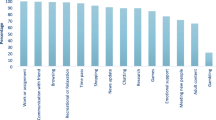Abstract
Objective
Internet addiction (IA) has been described as an emerging behavior related to the development of new technologies, with scarce studies on the subject and none involving medical students. The Internet Addiction Test (IAT) is a screening instrument used to detect IA worldwide, which was published in 1998 and inspired by the DSM-IV criteria for pathologic gambling. The objective of this study aims to measure the prevalence of IA in Chilean medical students and its possible association with demographic variables and depressive symptoms.
Methods
First- to fifth-year undergraduate medical students at a medical school in Santiago de Chile answered a self-administered survey that included demographic data, the IAT scale, and the Goldberg's General Health Questionnaire (GHQ-12) to screen for IA and depressive symptoms, respectively.
Results
Three hundred eighty-four students participated, achieving a response rate of 69.8 %, of which 11.5 % were classified as problematic users according to the IAT. The authors found a statistical association between positive results on the IAT and positive scores on the GHQ-12, as well as with the male gender.
Conclusion
In this first study of IA in medical students, the authors found a rate of incidence similar to what has been published in the literature focusing on college students. Additionally, there was a positive association between emotional symptoms and other abuse behaviors.
Similar content being viewed by others
References
Block JJ. Issues for DSM-V: internet addiction. Am J Psychiatry. 2008;165(3):306–7.
Hinic D. Problems with 'Internet addiction' diagnosis and classification. Psychiatr Danub. 2011;23(2):145–51.
Weinstein A, Lejoyeux M. Internet addiction or excessive internet use. Am J Drug Alcohol Abuse. 2010;36(5):277–83.
Holden C. Behavioral addictions debut in proposed DSM-V. Science. 2010;327(5968):935.
Petry NM, O'Brien CP. Internet gaming disorder and the DSM-5. Addiction. 2013;108(7):1186–7.
Siomos KE, Dafouli ED, Braimiotis DA, Mouzas OD, Angelopoulos NV. Internet addiction among Greek adolescent students. Cyberpsychol Behav. 2008;11(6):653–7.
Zboralski K, Orzechowska A, Talarowska M, et al. The prevalence of computer and Internet addiction among pupils. Postepy Hig Med Dosw (Online). 2009;63:8–12.
Cao F, Su L. Internet addiction among Chinese adolescents: prevalence and psychological features. Child: care, health and development. 2007;33(3):275–81.
Park SK, Kim JY, Cho CB. Prevalence of Internet addiction and correlations with family factors among South Korean adolescents. Adolescence. 2008;43(172):895–909.
Liberatore KA, Rosario K, Colon-De Marti LN, Martinez KG. Prevalence of Internet addiction in Latino adolescents with psychiatric diagnosis. Cyberpsychol Behav Soc Netw. 2011;14(6):399–402.
Berner JE, Santander J. Internet abuse and dependence: the epidemic and its controversy. Revista chilena de neuro-psiquiatría. 2012;50(3):181–90.
Ha JH, Kim SY, Bae SC, et al. Depression and Internet addiction in adolescents. Psychopathol. 2007;40(6):424–30.
Baker JR, Moore SM. Distress, coping, and blogging: comparing new myspace users by their intention to blog. Cyberpsychol Behav. 2008;11(1):81–5.
Yen JY, Yen CF, Chen CS, Tang TC, Ko CH. The association between adult ADHD symptoms and internet addiction among college students: the gender difference. Cyberpsychol Behav. 2009;12(2):187–91.
Ko CH, Yen JY, Chen CC, Chen SH, Wu K, Yen CF. Tridimensional personality of adolescents with internet addiction and substance use experience. Can J Psychiatry Revue Canadienne de Psychiatrie. 2006;51(14):887–94.
Tao ZL, Liu Y. Is there a relationship between Internet dependence and eating disorders? A comparison study of Internet dependents and non-Internet dependents. Eating Weight Disord: EWD. 2009;14(2–3):e77–83.
Christakis DA, Moreno MM, Jelenchick L, Myaing MT, Zhou C. Problematic internet usage in US college students: a pilot study. BMC medicine. 2011;9:77.
Choi K, Son H, Park M, et al. Internet overuse and excessive daytime sleepiness in adolescents. Psychiatry Clin Neurosci. 2009;63(4):455–62.
Cheung LM, Wong WS. The effects of insomnia and internet addiction on depression in Hong Kong Chinese adolescents: an exploratory cross-sectional analysis. J Sleep Res. 2011;20(2):311–7.
Young K. Internet addiction: the emergence of a new clinical disorder. Cyberpsychology Beh. 1998;1(3):237–44.
Jelenchick LA, Becker T, Moreno MA. Assessing the psychometric properties of the Internet Addiction Test (IAT) in US college students. Psychiatry Res. 2012;196(2–3):296–301.
Carvajal A, Centeno C, Watson R, Martínez M, Rubiales AS. How is an instrument for measuring health to be validated? An Sist Sanit Navar. 2011;34(1):63–72. Article in Spanish.
Goldberg D. The detection of psychiatric illness by questionnaire : a technique for the identification and assessment of non-psychotic psychiatric illness. London: Oxford University Press; 1972.
Santander J, Romero MI, Hitschfeld MJ, Zamora VU. Prevalencia de ansiedad y depresión entre los estudiantes de medicina de la Pontificia Universidad Católica de Chile. Revista chilena de neuro-psiquiatría. 2011;49:47–55.
King DL, Delfabbro PH, Griffiths MD, Gradisar M. Assessing clinical trials of Internet addiction treatment: a systematic review and CONSORT evaluation. Clin Psychol Rev. 2011;31(7):1110–6.
Author information
Authors and Affiliations
Corresponding author
Rights and permissions
About this article
Cite this article
Berner, J.E., Santander, J., Contreras, A.M. et al. Description of Internet Addiction among Chilean Medical Students: A Cross-Sectional Study. Acad Psychiatry 38, 11–14 (2014). https://doi.org/10.1007/s40596-013-0022-6
Received:
Accepted:
Published:
Issue Date:
DOI: https://doi.org/10.1007/s40596-013-0022-6




